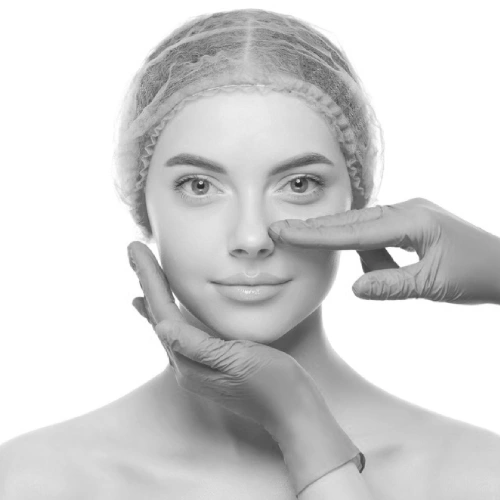Rhinoplasty
Rhinoplasty
Rhinoplasty, or “nose job,” is a popular choice for individuals dissatisfied with the size or shape of their nose. Beyond its well-known cosmetic advantages, rhinoplasty has evolved to offer versatile applications, addressing issues such as improving nasal function post-trauma or illness and alleviating breathing difficulties affecting sleep and exercise. The objective of rhinoplasty is to enhance both the aesthetic appearance and functionality of the nose, considering factors like skin type and overall facial architecture.

Why is Rhinoplasty performed?
– Modifying nose width, whether at the bridge or concerning nostril size and placement.
– Correcting nasal profile irregularities, including visible humps or depressions on the bridge.
– Refining the appearance of the nasal tip, whether it is enlarged, bulbous, drooping, upturned, or hooked.
– Reshaping and resizing nostrils that may be large, wide, or upturned.
– Rectifying nasal asymmetry by addressing imbalances in shape or size.

Surgical Rhinoplasty
Open Rhinoplasty
Open Rhinoplasty involves three incisions: two inside the nostrils and one external (trans-columellar). It offers clear visibility of the entire nasal structure, allowing precise measurement and evaluation of components in their natural alignment. This visibility facilitates accurate reshaping, graft placement, and reconstruction with enhanced precision and strength. Open Rhinoplasty is preferred for revision procedures, addressing large nasal humps, correcting the middle portion of the nose, and making significant changes to the nose’s shape and size.
Closed Rhinoplasty
Closed Rhinoplasty uses two incisions inside the nostrils for all modifications. The main advantage is the absence of external scarring, and the surgery is shorter with a quicker recovery. However, it has limitations in accessing internal nasal structures, making precise modifications to nasal bones and cartilages more challenging.
Recovery
After surgical Rhinoplasty, the internal packing is removed within 1-2 days, and the external plaster cast is taken off after 2 weeks. Initial symptoms such as swelling, pain, and redness can be managed with prescribed cold compresses and medications. While some nasal congestion and discomfort may persist, stitches are usually removed within the first week.
Patients can resume light activities within 2-3 days, with sedentary work feasible after a week. It is advised to avoid strenuous activities for a few weeks to support the healing process.
Visible improvements and an enhanced appearance become noticeable around 8-12 weeks, with ongoing enhancement during the healing process. Regular follow-up appointments with the surgeon are crucial for monitoring progress and addressing any concerns.
Non-Surgical Rhinoplasty
Non-Surgical Rhinoplasty, commonly referred to as the ‘non-invasive nose job,’ represents an innovative alternative to traditional surgery, providing desired aesthetic results without the need for a painful surgical procedure. Often dubbed the “15 Minute Nose Job” or Liquid Rhinoplasty, this technique employs dermal fillers to enhance nose size and contour. The procedure is swift, painless, and offers a quick solution to achieving the nose of one’s dreams, effectively addressing concerns like bumps, crooked noses, or drooping tips.
Filler Rhinoplasty
Filler rhinoplasty is a non-surgical cosmetic procedure using injectable fillers to reshape the nose, addressing imperfections like bumps or asymmetry. It provides a temporary and minimally invasive alternative to traditional rhinoplasty, offering enhanced nasal aesthetics without surgery.
Frequency of Non-Surgical Rhinoplasty Treatment:
Given its enduring effects, the treatment typically requires repetition after 8-12 months, with occasional touch-ups if needed. For soft tissue nose jobs, a series of up to three treatments may be performed over a few months to achieve the desired structural appearance.
Duration:
The entire non-surgical rhinoplasty procedure is a brief 15-20-minute session. Medication is provided for the subsequent 5 days to ensure a comfortable recovery.
Post-Treatment Care:
Following non-surgical rhinoplasty, comprehensive post-treatment care is offered, and the doctor remains accessible throughout the recovery period. This minimizes downtime and ensures optimal results with minimal inconvenience.
